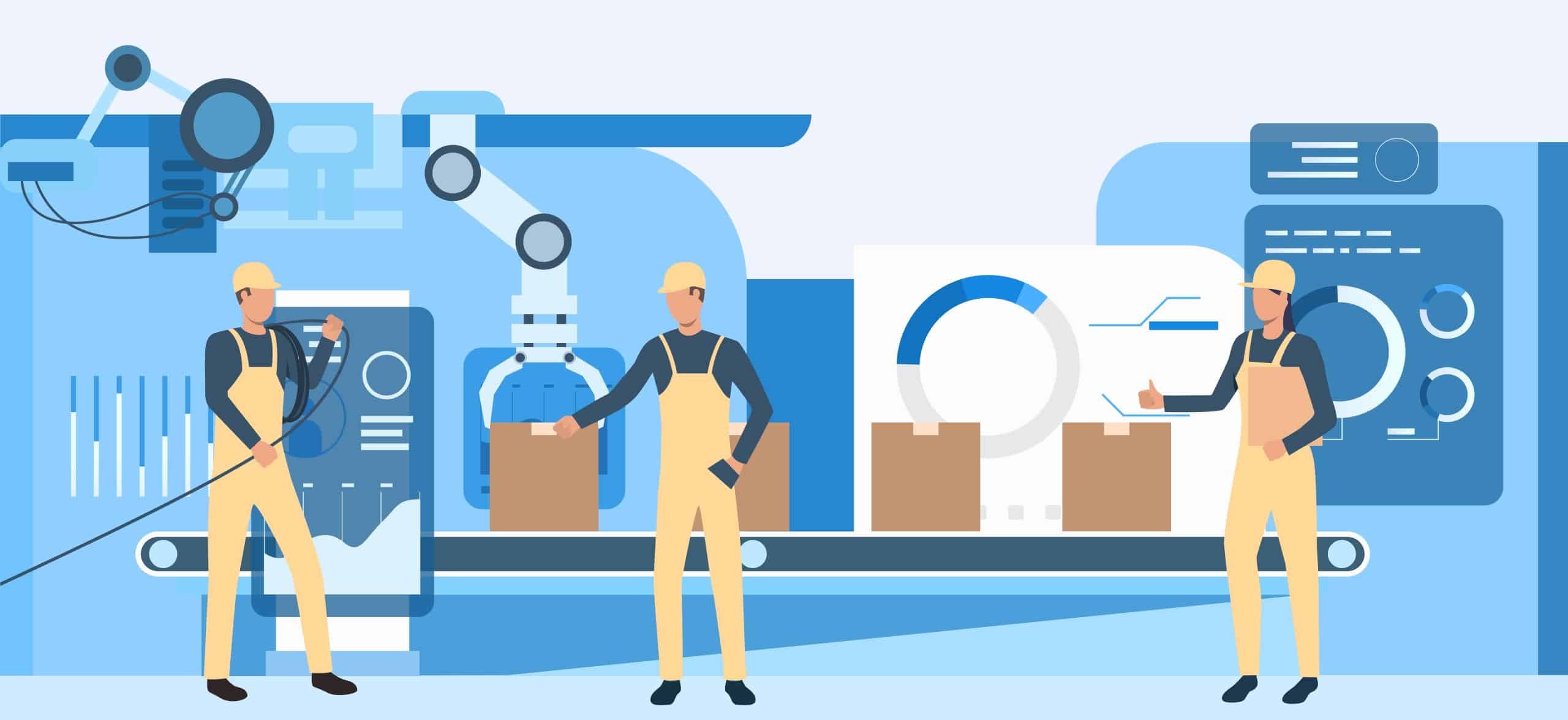Innovative Folding Techniques
Advanced folding methods in wet wipes manufacturing play a key role in enhancing product diversity and production line efficiency. The techniques have advanced greatly due to technological progress, especially through the incorporation of automation and artificial intelligence (AI).
1. AI-Powered Adaptive Folding
Modern wet wipes manufacturing methods utilize artificial intelligence to adjust the folding process dynamically. AI-driven robots can quickly transition between several intricate folding patterns based on real-time production requirements or preset algorithms, unlike prior systems that were restricted to a few fixed patterns. This versatility caters to various consumer tastes and enables manufacturers to try out new product kinds without needing long periods of reconfiguration.
2. Multi-directional folding mechanisms
Contemporary folding machines have multi-directional capabilities, allowing them to fold wet wipes vertically, horizontally, or in a spiral manner. This capability improves the performance of the wipes by, for example, generating pockets for improved grip or more efficient cleaning, while also adding visual appeal, which can set them apart in a competitive market.
3. Velocity and Accuracy
Innovative folding technology is characterized by high speed and precision. Recent advancements have concentrated on enhancing machines’ efficiency while preserving each wipe’s quality. High-speed cameras and sensors oversee the folding operation to guarantee each wipe is folded accurately at speeds that exceed manual capabilities. This enhances manufacturing efficiency and minimizes waste resulting from folding mistakes.
4. Integration with Other Production Stages
Folding is not a standalone process; it is an integral aspect of a comprehensive production cycle. Modern folding systems are now created to smoothly incorporate preceding (such as impregnation with solutions) and subsequent operations (such as stacking and packaging). This integration guarantees a seamless transition between each phase, sustaining the production pace and minimizing the occurrence of bottlenecks.
5. Personalized Fold Designs
The most recent technologies enable the customization of folding patterns that can be programmed into the system according to unique client requirements. This functionality is especially advantageous for private label businesses that may need distinct fold kinds to differentiate their products in the market.
The new folding methods are a major advancement in wet wipe production. By utilizing these technologies, wet wipes manufacturers may meet present market demands and easily adjust to future trends and shifts in consumer preferences.
Automated Stacking Solutions
Automated stacking systems play a vital role in the wet wipes production process by guaranteeing efficiency, accuracy, and scalability. With the industry shifting towards automated systems, these solutions have progressed by integrating robotics and advanced sensor technologies to enhance the speed and precision of stacking wet wipes.
1. Advanced Robotics
Contemporary automated stacking systems employ high-precision robots specifically created to perform intricate jobs quickly and accurately. The robots are fitted with sophisticated grippers capable of delicately handling each wet wipe to ensure a tidy and uniform stack. Precision is essential for ensuring product quality, particularly at high velocities, and aids in avoiding damage to the wipes while they are being stacked.
2. Fast Stacking
Efficiency is crucial in production, and modern automated stacking machines can handle thousands of wipes each minute. The systems are created to match the output of the folding machines, preventing any slowdown in the wet wipes production line. By combining high-speed cameras with real-time monitoring systems, modifications may be made instantly, minimizing downtime and optimizing throughput.
3. Integration with QC Systems
Automated stacking solutions are commonly used with quality control systems that consistently evaluate the product for flaws or anomalies. The wet wipes are scanned by sensors and cameras during processing, with machine learning techniques used to detect and discard any faulty products. This integration guarantees that only products that fulfill quality criteria proceed to the packaging process, improving the overall reliability of the product.
4. Adaptable Setup
Flexibility is essential in contemporary wet wipes manufacturing, and automated stacking systems are created to be easily reconfigurable for various types of wet wipes and packaging requirements. Wet wipes manufacturers may easily transition between product lines with minimal downtime, meeting various market demands and seasonal changes due to this versatility.
5. Sustainable Operations
Automated stacking systems in manufacturing play a vital role in enhancing sustainability by minimizing waste and improving energy efficiency. Contemporary systems are engineered to minimize movement, hence decreasing energy usage. Precise stacking minimizes waste by reducing product damage and errors, resulting in a higher number of made wipes that are ready for sale.
6. Optimization based on data analysis
Automated stacking systems may now optimize the stacking process by collecting and analyzing data through IoT technologies. The data can offer insights into trends in performance, possible mechanical problems, and operational inefficiencies. Wet wipes manufacturers can enhance their processes, anticipate maintenance requirements, and minimize unexpected downtime by utilizing this data.
Automated stacking systems demonstrate how technology may improve production efficiency and product quality in the wet wipes business. By combining robotics, sensor technology, and data analytics, these systems guarantee that the end product maintains a consistently high quality and is prepared to fulfill consumer requirements.
Integration of IoT and Data Analytics
Incorporating the Internet of Things (IoT) and data analytics into wet wipes manufacturing, namely in the folding and stacking systems, signifies a notable transition towards smarter and more adaptive production procedures. This connectivity allows wet wipes manufacturers to enhance operations, forecast maintenance requirements, and maintain uniform product quality.
1. Continuous Monitoring and Control in Real-Time
IoT devices, including sensors and cameras, are placed along the production line to gather data on different parts of the wet wipes manufacturing process. This encompasses wet wipes machine efficiency, environmental factors such as temperature and humidity, and product standards. The acquired data is sent in real-time to a central system for monitoring by engineers or AI systems. This enables quick modifications to be made to the process, such as altering the speed of a conveyor belt or increasing the moisture level in the wipes, to uphold ideal production conditions.
2. Anticipatory Maintenance
One major benefit of incorporating IoT into production systems is the capacity to do predictive maintenance. IoT systems can detect possible equipment failures by monitoring their state and recognizing patterns or anomalies. An example would be a vibration sensor detecting abnormal activity in the motor of a folding machine. Data analytics can analyze the information to forecast the probable failure of the motor and arrange maintenance at an opportune moment, thus reducing downtime and repair expenses.
3. Improved Quality Assurance
Data analytics is essential in quality control as it examines data from different sensors to guarantee that each product adheres to rigorous criteria. Optical sensors may verify the alignment and integrity of each wet wipe during the folding and stacking process. Machine learning algorithms can analyze the data to improve their ability to detect faults and pinpoint the underlying causes of prevalent problems. This results in a constant enhancement of product quality and a decrease in waste.
4. Optimizing the Supply Chain
IoT and data analytics provide advantages beyond the production floor by enhancing the efficiency of the supply chain. Wet wipes manufacturers can enhance wet wipes raw material stock management by combining production data with inventory levels and demand predictions to minimize overproduction or shortages. Ensuring synchronization between production runs and market demand enhances efficiency and decreases costs.
5. Energy Management
Contemporary IoT systems have features for monitoring and controlling energy consumption. Sensors monitor energy usage throughout manufacturing stages, while analytics identify patterns and pinpoint places where energy consumption can be decreased without compromising output quality. This aids firms in cost reduction and supports sustainability objectives by reducing the environmental footprint of production.
6. Personalization and Customer Analysis
IoT and data analytics ultimately allow for increased product flexibility and the ability to respond promptly to customer trends. Wet wipes manufacturers can enhance their production processes to align with consumer preferences by examining consumer data and feedback. Wet wipes manufacturers can adapt their production techniques to meet the growing demand for eco-friendly products, for as by increasing the manufacturing of biodegradable wet wipes.
The incorporation of IoT and data analytics in wet wipe manufacturing is revolutionizing the industry, enhancing its intelligence, efficiency, and ability to create superior and customized goods. This technology-driven strategy enhances competitiveness and is in line with the current trends of sustainability and consumer-focused manufacturing.
Sustainability Advances
Sustainability is gaining more importance in manufacturing, especially in the wet wipes manufacturing sector. Wet wipes manufacturers are incorporating sophisticated technologies and tactics to minimize environmental harm while upholding efficiency and product excellence.
1. Efficient Wet Wipes Machinery
Utilizing energy-efficient wet wipes machinery is a highly effective method to improve sustainability in production. The new folding and stacking machines are engineered to be more energy-efficient than the older models. Regenerative drives, which capture energy from the wet wipes machine’s mechanical actions like braking or decelerating, and energy-efficient components are now common features. These advancements decrease both the carbon footprint of manufacturing and operational expenses.
2. Techniques for reducing waste
Reducing waste is a critical component of sustainable production. When producing wet wipes, the goal is to reduce both material waste and rejected products. Cutting-edge sensor technologies and AI algorithms detect and rectify mistakes in real time during folding and stacking, thus decreasing the number of faulty items. Furthermore, advancements in cutting and folding techniques have led to a significant reduction in abandoned raw materials.
3. Optimizing Water and Chemical Usage
Most wet wipes are saturated with solutions containing water and a variety of chemicals. Modern systems now have more accurate application methods, guaranteeing the perfect distribution of solution on each wipe, while reducing spillage and waste. Recycling systems are used to process and reuse water and chemical combinations, which helps decrease the demand for new resources and reduces the discharge of chemicals into the environment.
4. Biodegradable and recyclable materials
Transitioning to biodegradable and recyclable materials in wet wipes manufacturing is a crucial move toward sustainability. Wet wipes manufacturers are investigating and embracing materials that can decompose faster in the environment or can be recycled more effectively. This not only decreases landfill trash but also meets the increasing consumer demand for eco-friendly products.
5. Analysis of life cycle and responsible management of products
Wet wipes manufacturers are increasingly using lifecycle analysis (LCA) methods to evaluate the environmental effects of their products throughout the whole production and disposal process. This complete perspective enables enhancements at each phase to reduce ecological footprints. Product stewardship initiatives, in which firms assume responsibility for the disposal or recycling of their items, are increasingly prevalent.
6. Integration of Renewable Energy Sources
Incorporating renewable energy sources like solar or wind power into the industrial process is a challenging although progressively attainable objective. Wet wipes manufacturers can significantly diminish their dependence on fossil fuels and lower their greenhouse gas emissions by using renewable energy to operate production lines.
7. Sustainable Packaging Options
Wet wipes packaging is now being innovated to be more sustainable. Utilizing recyclable or biodegradable packaging materials and designs that reduce plastic usage are important advancements. Some wet wipes manufacturers are adopting refill systems, allowing customers to buy refills for their containers, which helps decrease packaging waste.
The improvements in wet wipes folding and stacking methods regarding sustainability align with the industry’s focus on reducing environmental effects and addressing consumer demands for ethical manufacturing practices. With the ongoing advancement of technology and materials science, we anticipate the development of increasingly efficient and creative solutions.
Future Perspective
Technological improvements, shifting consumer tastes, and environmental regulations will affect the future of wet wipe production, especially in folding and stacking systems.
1. Advanced Robotics and Automation
With the advancement of robotics technology, we anticipate increased automation in wet wipes manufacturing becoming more intricate. In the future, systems are expected to have improved robotic dexterity, enabling them to do more intricate tasks with more precision, leading to increased production efficiency and product quality. The combination of AI and robots will improve the systems’ capacity to learn from data and make immediate adjustments to optimize the production process.
2. Enhanced Personalization and Customization
Wet wipes manufacturers may utilize technology that enables rapid customization to meet individual consumer demands and preferences. This may involve wet wipes machines that can quickly alternate between many types of wet wipes, including varied sizes, smells, or substances, with minimal downtime. Flexibility can be a competitive advantage, especially for brands targeting specific markets or offering customized products.
3. Innovations in sustainability
Sustainability will be a significant factor in the development of manufacturing technology. In the realm of wet wipes, this might involve creating innovative materials that are eco-friendly, biodegradable, and high-performing. In addition, wet wipes manufacturing processes are expected to become more energy-efficient and less wasteful by implementing closed-loop systems that recycle water and chemicals extensively.
4. Smart Technology Integration
In the future, wet wipe manufacturing may involve a more profound incorporation of smart technologies, leading to smarter and more linked factories. IoT devices may become increasingly widespread, offering extensive monitoring and control abilities across the whole supply chain. This could enhance both production efficiency and supply chain responsiveness, hence decreasing the time from production to market delivery.
5. Regulatory Compliance and Safety Standards
With governments globally enacting more stringent laws concerning product safety and environmental effects, compliance will become a growing priority. Future manufacturing systems must be developed with adaptability to changing rules, including integrating functions for automated tracking and reporting of compliance indicators.
6. Advanced Materials Science
New wet wipes raw materials are expected to be essential for the future of wet wipes. Innovations could involve the development of novel fibers or nonwoven materials that provide enhanced performance or have better environmental characteristics. Chemical compositions in wet wipes for cleaning and sanitizing will keep advancing due to progress in chemistry and changes in regulatory and consumer requirements related to safety and environmental effects.
7. Consumer Engagement and Feedback Mechanisms
As consumers become more knowledgeable and interested in the items they use, manufacturers will use digital tools more to interact with consumers directly. This could involve utilizing data analytics to collect and evaluate consumer input in real-time, enabling wet wipes manufacturers to make more dynamic adjustments to product features or production processes.
The upcoming advancements include technological, environmental, and social trends that will likely influence the wet wipes manufacturing business in the future. As these technologies and techniques advance and are incorporated into production processes, they are expected to deliver more efficient, adaptable, and environmentally friendly manufacturing solutions.






